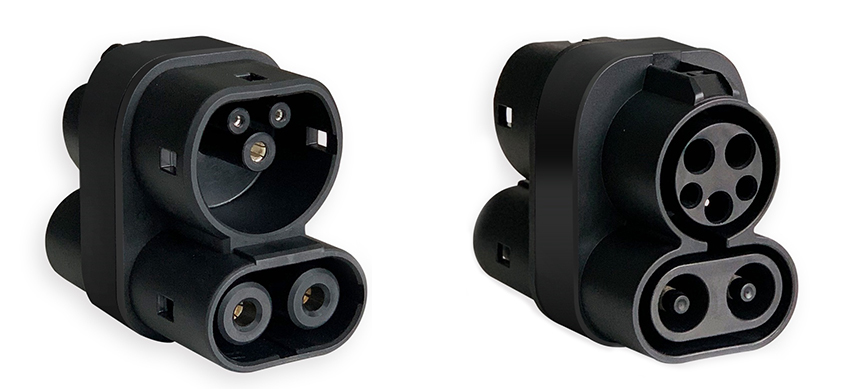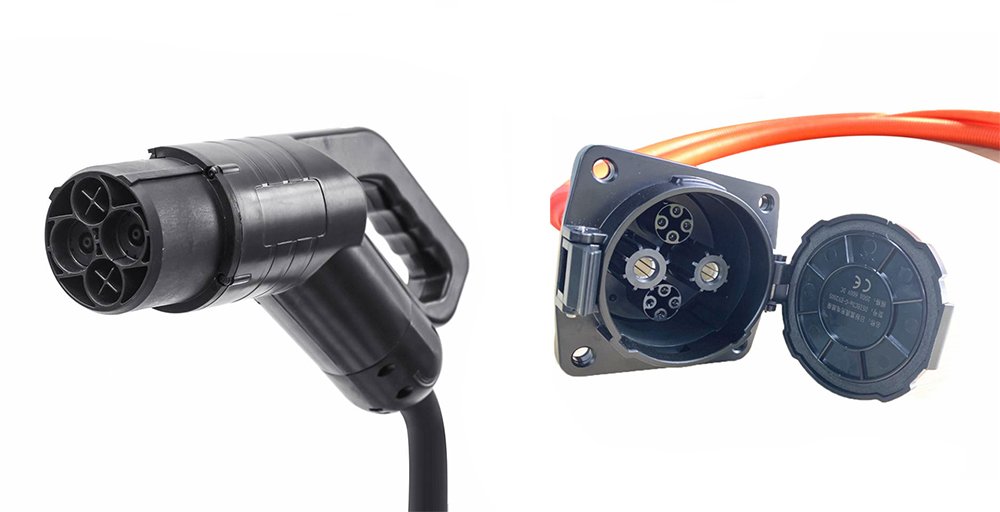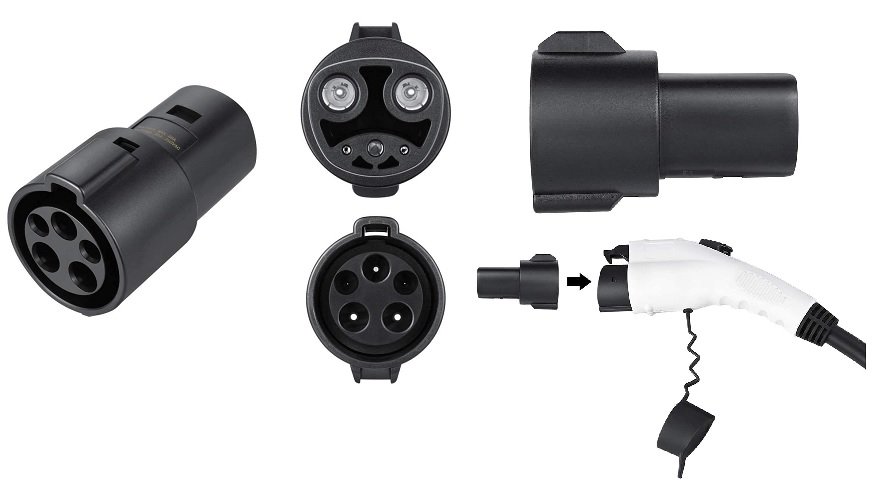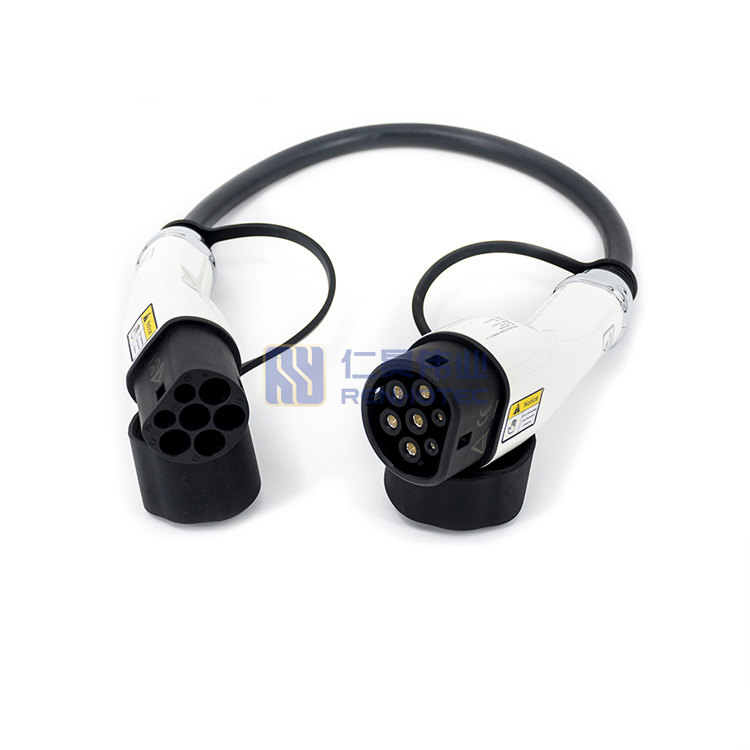There are five Standard EV Charging Connectors, the following is their detailed introduction. With the increasing support for electric vehicles in various countries and the construction of more and more charging stations, the standards of various countries are already facing a situation of direct conflict. Energy-saving and environmentally-friendly electric vehicles have become an inevitable trend in the automotive industry. However, while car companies in various countries are devoting themselves to the research and development of electric vehicle technology, the charging standards of electric vehicles are also an important factor affecting their popularity.
Overview
Combo Connector
The Combo socket can allow slow charging and fast charging of electric vehicles. It is currently the most widely used socket type in Europe, including Audi, BMW, Chrysler, Daimler, Ford, GM, Porsche, and Volkswagen all equipped with charging interfaces developed by SAE(American Society of Automotive Engineers).
Energy-saving and environmentally-friendly electric vehicles have become an inevitable trend in the automotive industry. However, car companies in various countries are devoting themselves to the research and development of electric vehicle technology. The charging standards of electric vehicles are also an important factor affecting their popularity. With the increasing support for electric vehicles in various countries and the construction of more and more charging stations. The standards of various countries are already facing a situation of direct conflict. Below, I will sort out the 5 major charging connector standards currently on the market for everyone.
On October 2, 2012, the SAE J1772 revised draft voted by SAE committee members became the only official DC charging standard in the world. The introduction of this standard is to change the status quo of mixed charging systems. Enhance consumers’ enthusiasm for purchasing electric vehicles.

Advantages of Combo Connector
In the future, automakers can use a socket on their new models. Not only for the first generation of smaller basic AC connectors but also for the second generation of larger Combo Connectors. Combo Connector can provide DC and AC current, charging at two different speeds respectively.
Disadvantages of Combo Connector
In the fast charging mode of the Combo Connector, the charging station needs to provide a maximum voltage of 500 volts and a current of 200 amps.
CHAdeMO Connector
It is a kind of EV charging Connectors. CHAdeMO is the abbreviation of CHAde de Move. Japan’s Nissan and Mitsubishi Motors support it. CHAdeMO translates from Japanese and means “charging time is as short as a tea break”. This DC fast charging socket can provide a maximum charging capacity of 50kw.

CHAdeMO Supported Cars
Electric vehicle models that support this charging standard include Nissan Leaf, Mitsubishi Outlander plug-in hybrid, Citroen C-ZERO, Peugeot iON, Citroen Berlingo, Peugeot Partner, Mitsubishi i-MiEV, Mitsubishi MINICAB-MiEV, Mitsubishi MINICAB-MiEV truck, Honda Fit electric version, Mazda DEMIO EV, Subaru Stella plug-in hybrid, Nissan eEV200, etc. It should be noted here that both Nissan Leaf and Mitsubishi i-MiEV electric vehicles have two different charging sockets. One of which is suitable for the basic J1772 connector, which is the Combo connector introduced in the first part; the other is suitable for The CHAdeMO standard connector in Japan.
CHAdeMO Fast Charge Method
As shown in the figure, the car’s CAN bus signal controls the current. That is while monitoring the battery status. It calculates the current value required for charging in real-time, and sends a notification to the charger through the communication line; the fast charger receives the current command from the car in time and provides the current according to the specified value.

How CHAdeMO Works
The battery management system monitors the battery status while controlling the current in real-time, which fully realizes the functions required for fast and safe charging, and ensures that the charging is not limited by battery versatility. In Japan, 1,154 quick chargers installed in accordance with CHAdeMO standards have been put into use. In the United States, CHAdeMO charging stations have also been widely “cast a net”. The latest data from the US Department of Energy shows that there are 1,344 CHAdeMO AC fast-charging stations in the United States.
Advantages of CHAdeMO Connector
In addition to the data control line, CHAdeMO also uses the CAN bus as the communication interface. Due to its superior noise resistance and high error detection capability, it has high communication stability and reliability. The industry affirmed its good charging safety record.
Disadvantages of CHAdeMO Connector
CHAdeMO originally designed a charging output power of 100 kilowatts, and the connector is very heavy. But the output power in a charging car is only 50 kilowatts.
Tesla
It is a special kind of EV charging Connectors. Tesla has its own set of charging standards, claiming to be able to charge more than 300 kilometers in 30 minutes. Therefore, the maximum capacity of the charging socket can reach 120kw, and the maximum current can reach 80A.
As of February 18, 2021. Tesla operates over 30,000 Superchargers in over 2,564 stations worldwide (an average of 9 chargers per station). There are 1,101 stations in North America, 592 in Europe, and 498 in the Asia/Pacific region.

Advantage of Tesla Superchargers
Advanced technology and high charging efficiency.
Disadvantages of Tesla Supercharger
It is only applicable to Tesla models. Its standards are contrary to other national standards. The number of proprietary charging piles has increased slowly; if Tesla compromises and adopts a common standard charging protocol, it will affect the charging efficiency.
Combined Charging System
In order to change the current state of chaotic charging interface standards. The eight major American and German manufacturers Ford, General Motors, Chrysler, Audi, BMW, Mercedes-Benz, Volkswagen, and Porsche released a “joint charging system” in 2012. “Combined Charging System”, or “CCS” standard.

Charging Mode Supported by CSS
The “joint charging system” can unify all current charging interfaces, so that four modes of single-phase AC charging, fast three-phase AC charging, household DC charging, and ultra-fast DC charging can be completed with one interface.
CSS Auto Dealer
SAE has selected the joint charging system as its standard. In addition to SAE, the European Automobile Manufacturers Association (ACEA) has also announced that it has selected the joint charging system as the DC/AC charging interface, which will be used for all plugins sold in Europe from 2017. Electric car. Since Germany and China unified the charging standards for electric vehicles last year, China has also joined the European and American camps, bringing unprecedented opportunities for the development of electric vehicles in China. Zinoro 1E, Audi A3 e-Tron, BAIC E150EV, BMW i3, Tenshi, Volkswagen e-up, Changan Yidong EV, and Smart EV all belong to the “CCS” standard camp.
Advantage of CCS
The three German automakers are BMW, Daimler, and Volkswagen. They will increase their investment in electric vehicles in China, and the CCS standard will be more favorable to China.
Disadvantage of CCS
Electric vehicles that support the “CCS” standard either have a small sales volume or have just begun to go on sale.
GB/T 20234
In 2006, China issued the “General Requirements for Plugs, Sockets, Vehicle Couplers and Vehicle Jacks for Conductive Charging of Electric Vehicles” (GB/T20234-2006). This national standard specifies charging currents of 16A, 32A, 250A AC, and the connection classification method of 400A DC. Mainly draws on the standard proposed by the International Electrotechnical Commission (IEC) in 2003, but this standard does not specify the number of connection pins, physical dimensions, and interface definitions of the charging interface. In 2011, China introduced the GB/T20234-2011 recommended standard, replacing part of the content in GB/T20234-2006, which stipulates: AC rated voltage does not exceed 690V, frequency 50Hz, rated current does not exceed 250A; DC rated voltage Does not exceed 1000V, and the rated current does not exceed 400A.

Advantages of GB/T 20234
Compared with the 2006 version of the national standard, more charging interface parameters have been calibrated in detail.
Disadvantages of GB/T 20234
The standard is still not perfect. In addition, it is only a recommended standard, and it is not enforced.
Summarize
The above is Five standards for EV charging Connectors in the world. Automobile companies in various countries have gradually realized that “standards” are the key factor that influences the development prospects of electric vehicles. We have also seen that in recent years, global charging standards have gradually shifted from “diversification” to “centralization”.However, in order to truly achieve uniform charging standards, in addition to interface standards, current communication standards are also required. The former is related to whether the connectors are consistent, and the latter affects whether the plug can be energized when inserted. There is still a long way to go to unify the charging standards for electric vehicles. Car companies and governments of all countries need to further “open up their posture” for electric vehicles to have a future.

